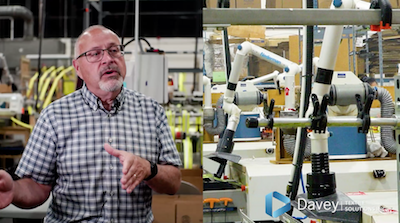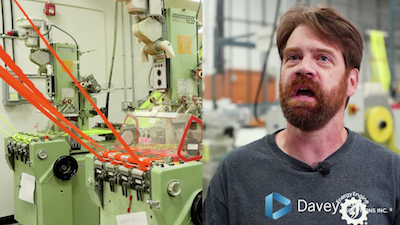Digital transformation at Davey makes the entire team more efficient, more effective, more productive
When a thread breaks on a loom, a tweet over Twitter is sent to alert staff in the weaving room.
It’s an innovative first step in the digital transformation of Edmonton-based Davey Textile Solutions in its efforts to increase productivity and create a competitive advantage in the marketplace.
“It’s data collection now,” says Dan King, vice-president of operations at Davey, a manufacturer of high-quality safety trim for workwear. “I see what (the data) says and how I can improve. In the future, it’ll be machine learning and AI.” 
King knew what he wanted to do several years ago, but it was an extremely complicated project to extract data from their equipment for broader use and to integrate information from the multiple systems and vendors that are found on the shop floor.
He brought in consultant Dave Shook, formerly with Shook IOT that is now part of Uptake in Chicago, to work with the Davey team.
The digitization pilot project started with the looms as the woven product is the base for everything produced at Davey.
Devices in little grey boxes were installed on the looms that detect when a specific loom stops, and why, and send that information up to the cloud. That information is then sent via a tweet to operators, who have their phones and can be notified directly through their hearing protection devices.
“Collecting data from their operating equipment allows Davey to understand how fast the equipment is running, how much it’s producing and also, when the equipment stops, how long it stops for,” says Shook.
Staff on the shop floor can respond quickly when something minor breaks, which is most of the time. Or they can decide to wait to respond when the notification is of a more complex issue.
“It also allows Davey to understand what the causes are of equipment stoppages: is it always the same thing that breaks, is it always the same raw material, is it always on the same finished product, is it on certain materials on certain equipment,” explains Shook.
 “It provides very high-quality data that the people at Davey can use to improve their operations over time.”
“It provides very high-quality data that the people at Davey can use to improve their operations over time.”
Giving people access to that type of data so they can make better business decisions is the whole goal of digitization, says Shook.
“Digitization gets a lot of hype. In a semi-automated environment like Davey it doesn’t mean replacing workers or equipment. What it means is making it so that the workers and the equipment are working on the right stuff.
“The overarching benefit is it enables better decision-making. Everyone in the company is working off the same set of facts … and it makes people more effective and more efficient and more productive.”
Craig Cameron, operations coordinator at Davey, is excited about the digitalization project.
Previously, Cameron says, a trouble light went on when something wasn’t working, which wasn’t particularly helpful.
“Now we’re getting information in real time we could never get before,” he says. “It’s easier to take action backed up by hard data instead of guesswork.”
Cameron says the textile plants have been slow to make a digital transformation compared to others in the manufacturing industry. “I’m surprised no one’s done it before.” 
The weaving room project with the looms is just about complete, and Phase 2 and 3 have been approved so that the grey boxes will be installed on all equipment at Davey in the near future.
Although King knows digitization will be a long-term project at Davey.
“It’s a passion for me to be a leader and innovator in technology. I just believe that’s the future and where we need to be.”
King sees digitization as the way to retain business in North America by reducing costs and getting more efficient when so much textile production has been going offshore to Asia and other countries.
“I believe the way to keep globally competitive is to get that data from those devices so that I can get better all the time,” he says.
“In the future it’ll be a direct feedback loop: I’ll draw the data out so the machine will go back and fix itself. That’ll be the focus in the future.”











